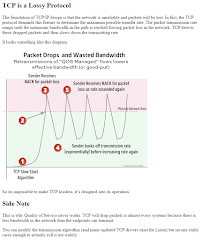Category: TCP
Policing or Shaping? It Depends
One of my readers watched my TCP, HTTP and SPDY webinar and disagreed with my assertion that shaping sometimes works better than policing.
TL&DR summary: policing = dropping excess packets, shaping = delaying excess packets.
Here’s the picture he sent me (watch the video to get the context and read this article to get the background details):
TCP Congestion Avoidance on Satellite Links
While some people spread misinformation others work hard to figure out how to make TCP work on exotic links with low bandwidth and one second RTT.
Ulrich Speidel published a highly interesting article on APNIC blog describing the challenges of satellite Internet access and the approach (network coded TCP) they took to avoid them.
On the Lossiness of TCP
When someone tells you that “TCP is a lossy protocol” during a job interview, don’t throw him out immediately – he was just trusting the Internet a bit too much (click to enlarge).
Everyone has a bad hair day, and it really doesn’t matter who published that text… but if you’re publishing technical information, at least try to do no harm.
Whatever Happened to “Do No Harm”?
A long time ago in a podcast far, far away one of the hosts saddled his pony unicorn and started explaining how stateful firewalls work:
Stateful firewall is a way to imply trust… because it’s possible to hijack somebody’s flows […] and if the application changes its port numbers… my source port changes when I’m communicating with my web server - even though I’m connected to port 80, my source port might change from X to Y. Once I let the first one through, I need to track those port changes […]
WAIT, WHAT? Was that guy really trying to say “someone can change a source port number of an established TCP session”?
Published: Designing Scalable Web Applications
The first batch of the latest materials for my Designing Scalable Web Applications course have been published on my free content web site.
TCP Optimization with Juho Snellman on Software Gone Wild
Achieving 40 Gbps of forwarding performance on an Intel server is no longer a big deal - Juniper got to 160 Gbps with finely tuned architecture - but can you do real-time optimization of a million concurrent TCP sessions on that same box at 20 Gbps?
Juho Snellman from Teclo Networks explained how they got there in Episode 25 of Software Gone Wild… and you’ll learn a ton of things about radio networks on the way.
Packet Reordering and Service Providers
My “Was it bufferbloat?” blog post generated an unexpected amount of responses, most of them focusing on a side note saying “it looks like there really are service providers out there that are clueless enough to reorder packets within a TCP session”. Let’s walk through them.
TCP Is a Stream Protocol
I hope you know TCP provides a reliable stream service not reliable packet delivery, but you might not have realized all the implications – I found an old post by Robert Graham explaining how things really work and how you can use them to bypass quick-and-dirty IDS that rely on signatures instead of doing proper protocol decodes.

